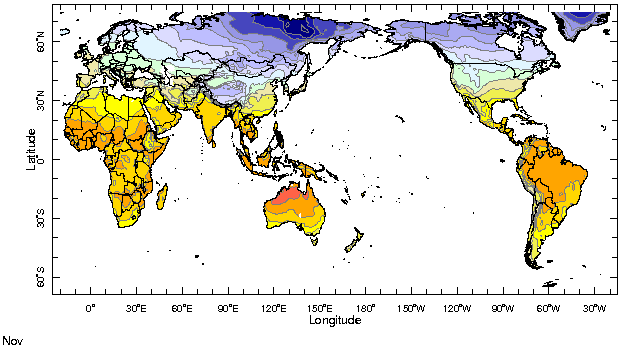|
IRI Climate Digest
December 2003
November Global Climate Summary
Climatological Background
During November, the Northern Hemisphere mid-latitude storm tracks increase in strength, while monsoon systems in South Africa, Australia, and South America expand southward following the maximum solar heating. Tropical storm activity winds down in the North Atlantic, the North Pacific and northern Indian Oceans.
Monthly Mean Temperature (1961-1990), data from the Climate Research
Unit, University of East Anglia


Monthly Mean Precipitation (1961-1990), data from the Climate Research
Unit, University of East Anglia


Temperatures
Highlights
Africa: During November, most of Africa continued to experience the above-average temperatures that spread across the continent in October.
Europe: The break in relatively warm conditions experienced across much of Europe during October came to an end in November as above-average temperatures returned to the continent.
Asia: Cooler-than-normal conditions were observed across north-central Asia while above-average temperatures were seen in southeast Asia. Above-average temperatures were also experienced in eastern Russia, continuing a warm trend that began there in September.
South America:Much of South America experienced normal conditions during November, though above-average temperatures were seen in the northeastern and southwestern portions of the continent.
North America:The above- and below-average temperatures experienced in the eastern and western portions of North America, respectively, were consistent with the observed negative phase of the Pacific North American pattern during November. Warmer-than-normal conditions were also seen in the extreme northern Canada and much of Alaska.
Temperature Difference from the 1961-1990 mean, with data
from NCEP Climate Prediction Center, CAMS.


Precipitation
Highlights
East and Southern Africa: As of the end of November, the short rains had not become well established in northern Tanzania and neighboring Rwanda and Burundi. Below-average precipitation anomalies were were found throughout most of Tanzania in November (especially in the east) and in much of southern Africa as well.
Europe: With the exception of parts of the Iberian peninsula and northern Italy, most of Europe received below-normal precipitation in November. The largest deficits existed in southeastern Europe and western Turkey.
East Asia: The Yellow River Basin of China has persistently received much greater than average precipitation since August. This trend continued at the end of the rainy season in November. Most of central and southern Japan and the Korean peninsula experienced above-normal precipitation amounts in November as well. Central Vietnam received heavy rainfall which induced flooding for the second month in a row. Dry conditions prevailed in the Philippines.
North America: Much of the eastern United States observed above-normal precipitation, particularly the Great Lakes region. Some areas of the northern Rocky Mountains in the U.S. welcomed larger than average precipitation amounts.
South America: Areas of southern Peru and northern Bolivia and parts of north-central Argentina observed below-normal precipitation amounts during November. Several locations in Colombia received greater than average rainfall during the month which produced flash floods and landslides. Most of Uruguay and neighboring areas of southern Paraguay and eastern Argentina experienced above-normal precipitation.
Indonesia and Australia: With the exception of much of Sumatra, eastern Java and neighboring islands to the east, dry conditions prevailed throughout most of Indonesia. In Australia, eastern Queensland received below-normal precipitation, while many areas in Western Australia experienced heavier than average rainfall.
Precipitation Difference from 1961-1990 mean, with data
from NCEP Climate Prediction Center, CAMS-OPI.


Oceanic Conditions
Tropical Pacific: Sea surface temperatures across the equatorial Pacific remained slightly warmer than average in November with above normal temperatures developing in the easternmost portion of the basin. However, overall conditions remain near neutral and are not expected to change significantly in the season ahead. See the latest IRI ENSO Update for a detailed summary and outlook.
Tropical Atlantic: Sea surface temperatures remained slightly above normal throughout most of the northern tropical Atlantic Ocean. The largest temperature departures were found along much of the western coast of Africa.
Indian Ocean: The above-average temperatures in the central Indian Ocean cooled slightly in November. An area of above-average sea surface temperatures developed in the southern Indian Ocean between 70°E and 100°E.
Mid-latitudes: The above-average sea surface temperatures in much of the North Atlantic basin moderated slightly in November. Warmer than normal SSTs developed in the South Atlantic off the coast of Argentina. A small area of warmer than normal sea surface temperatures persisted in the central North Pacific and above-normal temperatures developed westward toward Japan. Temperatures in the eastern North Pacific moderated slightly in November. Conditions in the South Pacific changed little between October and November.
Monthly Sea Surface Temperature Difference from the 1971-2000 mean,
with data from the Environmental Modeling Center, NCEP/NOAA.


Contents |
Special |
Impacts |
Climate |
Forecast
|

